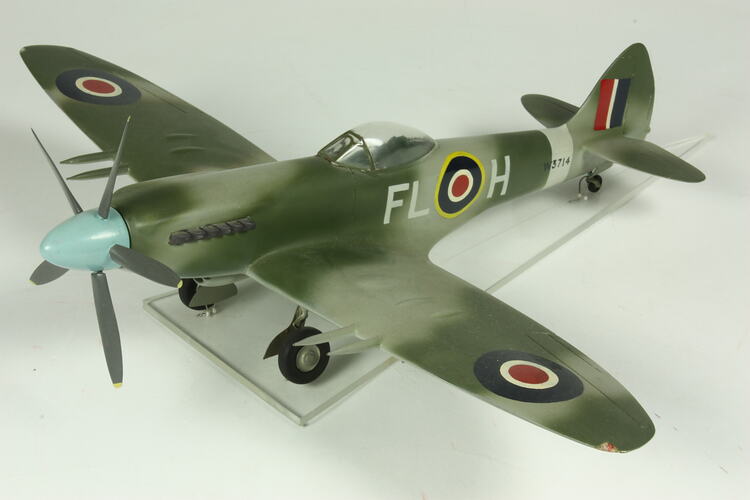Summary
Aircraft History
First flown in March 1936, the Spitfire was designed by Reginald Mitchell, chief designer for Supermarine Aviation Works (Vickers) Ltd. It was the first production fighter aircraft for the Royal Air Force to feature all-metal aluminium stressed-skin construction. It was available in sufficient numbers to equip 19 RAF squadrons at the outbreak of World War II in September 1939. The Spitfire's role in the Battle of Britain has been well documented although the Hawker Hurricane equipped many more units during the period of the Luftwaffe's air campaign against Britain between July and October 1940. The Spitfire's airframe and engine was constantly developed throughout the war and a naval version was produced known as the Seafire. Many Australians flew Spifires with the RAF and RAAF squadrons in Europe.
From 1942, Spitfires were supplied to the Royal Australian Air Force in Australia. The first examples were assembled and test-flown at Laverton RAAF base near Melbourne. Both Mk. V and Mk. VIII models were operated by the RAAF in Northern Australia and the South-West Pacific Area between 1942 and 1945. Most surviving aircraft were withdrawn from service by 1946 and scrapped at Oakey in Queensland. The Mk. 22 version was produced after World War II and was flown solely by the RAF. It was fitted with the 2,375 horsepower Rolls-Royce Griffon engine. Only about 280 Mk.22 Spitfires were built out of a total Spifire production of just over 20,300. One Mk. 22 Spitfire exists in Australia, serialled PK481. It was purchased in the UK by the the RAAF Association in Perth in 1958. It arrived in 1959 and is still displayed at the RAAFA Museum at Bull Creek.
Model History
This 1:32 scale model was built by Finecraft Scale Models of Crows Nest New South Wales. It was purchased by the Museum in October 1952 apparently for the Jubilee of Flight exhibition at the former Science Museum of Victoria. The code letters on the fuselage belong to 81 Squadron RAF but it appears they are taken from a wartime aircraft and are not correct for a post-war Spitfire.
More Information
-
Collecting Areas
-
Acquisition Information
Purchase
-
Modelmaker (Probable)
Finecraft Scale Models, 24 Falcon Street, Crows Nest, Greater Sydney, New South Wales, Australia, 1952
-
Brand Names
-
Classification
Air transport, Aircraft, Model propeller aircraft - military
-
Category
-
Discipline
-
Type of item
-
Overall Dimensions
312 mm (Width), 278 mm (Depth), 107 mm (Height)
Measurements of model only. 'Width' is model wingspan, 'Length' is model length from nose to tail, 'Height' is overall model height while resting on its undercarriage.
-
Other Dimensions
322 mm (Length), 312 mm (Width), 110 mm (Height)
Overall measurements of model including its base. 'Width' is model wingspan, 'Length' is model length from model nose to tail end of base, 'Height' is overall model height including base.
-
Model Scale
1:32
-
Keywords
Aeroplanes, Fighters, Military Aircraft, Model Aeroplanes, Scale Models, Supermarine, Wars & Conflicts
